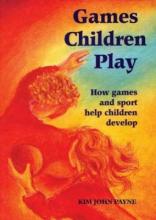
Games Children Play: How games and sport help children develop was written by Kim Brooking-Payne and published in 1996 by Hawthorn Press. The book offers descriptions of 230 games appropriate for children from age three through the teenage years. The aim of the book is not only to outline ways of organizing children’s games, but also to give insight into why the game is appropriate for a particular age or stage of development. Hints for teaching games to children and examples of how to work with introverted, unfocused, over-dominant, and stubborn children are given.
With the onslaught of electronic media, many children are beginning to lose the traditional games that play a vital role in learning, creativity, and the ability to interact socially in a healthy way. As children are taught games, they will have the opportunity to learn a forgotten but once much-loved language, the language of games.
The book suggests three aspects to consider when presenting a game: abstraction, pictorial, and imitative. Some children, especially as they get older, have the ability to follow an explanation given in a verbal, abstract way to understand how a game will be played. Others relate better to an explanation that has images, pictures, or a story to describe the game play. A pictorial approach allows the children to use their imaginations, while taking away from the focus on physical ability to successfully join the game. The imitative approach is best for those children who prefer to see the game or activity demonstrated before joining in. All three of these aspects can be dominant at differing ages, and the leader needs to be sensitive to the needs of the players.
Suggestions for explaining a game include several ways to pick teams, to keep children engaged, and to recognize when the game is ending. Because games can counteract bullying, carefully designed and supervised games can help control the level of exposure and contact between the bully and the victim as well as offer opportunities for better understanding of children’s differences. Recognizing the differences in temperaments of children can help the leader deal with those who sabotage the game and break the rules. The book offers in-depth descriptions of the four temperaments with suggestions for mitigating the disruptions children with each temperament may pose.
The book is divided into parts based on the ages of the children and their development at the various stages. Part One: Secrets of the Magic Garden contains activities and games for children ages 3 through 7. Chapter 1: Age 3-6 explores finger games and circle games. Finger games enable children to develop fine motor skills as well as develop body awareness. The actions to accompany the songs along with the melodies used are given. Chapter 2: Age 6-7 describes games such as Mother May I? as well as clapping games, beanbag games, chasing games, counting out rhymes, and string games. Chapter 3: Water games suggests games to encourage children to enjoy the water before learning to swim.
Part Two: Exploring the House offers games for the 7-12 year-old. Chapter 4: Age 7-8 introduces skipping games with jump ropes as well as games using equipment such as marbles, bean bags, and balls. Chapter 5: Age 9-10 addresses the changes in lives of children at this age as they sense their individuality more and become more independent. Chase games and games of tag are introduced. Chapter 6: Age 10-11 contains more advanced games with more equipment such as wooden staffs, floor mats, and balls. Team play is involved in many of the games. Chapter 7: Re-discovering the Playground seeks to reintroduce playground games where children can play with little supervision. Four square, rock-paper-scissors, reflex games, and marbles are described. Chapter 8: Age 11 – The Greek Olympics, Beauty, Truth, Strength describes the events of the marathon, the dash, the mini marathon, the running jump, the weight jump, the high jump, wrestling, discus, javelin, and the relay race for an Olympic event for children and the preparations for it. Chapter 9: Age 11-12 – Twilight and dawn describe games offered to children of this stage of development where they have reached a period of balance and harmony as they become more self-assured about themselves but still have a group-consciousness. Many of these games use volleyballs and introduce skills that are used in team sports.
Part Three: Beyond the Doorway – A movement programme for teenagers explores the differences between play and team sports and the origins of individual sports. Chapter 10: Age 12-13 and upwards makes a distinction between “playing with sport” and “playing the sport.” Rather than playing the well-defined team sport, children at this age, if left to their own devices, will often invent complex rules blending the imaginative, creative play of childhood with the game. While sports offer many positive influences in teenagers’ lives, the author expresses concern for starting children prematurely in team sports before they are developmentally ready for them. The author also discourages martial arts and ballet as activities for children. Chapter 11: Age 13 and beyond – Symbolism and History, of Sport describes the origins and history of sport. This chapter also describes the developmental changes in each of the teenage years and the sports that are appropriate for each stage. Also activities to help children over the age of 16 develop spatial awareness are given.1
- 1. Brooking-Payne, Kim. Games Children Play: How games and sport help children develop. Stroud, UK: Hawthorn Press. 1996.

